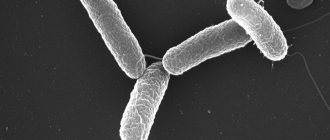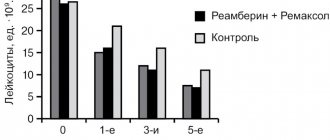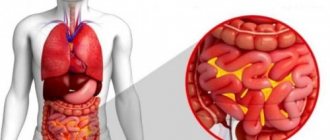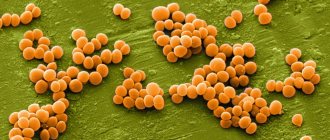The time has come for summer holidays, which is also the long-awaited season of fresh berries, vegetables and fruits, swimming in the gentle waters of rivers and seas, and... intestinal infections. Unfortunately, the peak incidence of infectious intestinal diseases occurs during the warm season. High air humidity, heat, food contaminated with microbes, lack of personal hygiene and violation of food storage rules contribute to the spread of infectious agents. The most common diseases among the population, called intestinal infections, are dysentery and salmonellosis.
What should you know about dysentery? How to protect yourself and your loved ones from this infection? We will talk about this and much more today in this article.
Dysentery is an infectious disease that occurs with intestinal damage and intoxication.
With the light hand of Hippocrates, this infectious disease received the name “dysentery” (from the Greek “dys”, which means “disorder”, and “enteron”, which means “intestines”). In Ancient Rus', the disease was called “bloody womb”, and today the disease is called shigellosis because of the name of the pathogens - Shigella - from a large and “friendly” family of enterobacteria.
Ways of transmission of the disease
The source of intestinal infection is patients with dysentery or bacteria carriers, that is, people who have no manifestations of the disease, but are infectious to others.
The causative agents of this acute intestinal infection enter the body with food, water, through contaminated household items, dishes, toys and unwashed hands.
Infection occurs due to non-compliance with personal hygiene rules - dysentery, typhoid fever, helminthiasis, cholera, salmonellosis and hepatitis A are diseases of “dirty hands”.
You can also become infected with dysentery by swimming in polluted waters.
Quite often the cause of the disease is our carelessness. You finished eating expired yogurt or bought shawarma on the beach - what’s wrong with that? For some it may be nothing, but for others such an experiment with their health may result in treatment.
Dysenteric geography
Bacterial dysentery is more common in European countries, amoebic dysentery - in India and Mexico.
Tourists planning a trip and getting vaccinated against dysentery should not forget about this.
It has been observed that children, adolescents and people with chronic diseases are more susceptible to bacillary dysentery.
Sonne's dysentery is most often caused by dairy products contaminated with bacteria; Flexner's dysentery is transmitted through contaminated water; amoebic dysentery can be “caught” by eating unwashed vegetables, herbs, and contaminated water.
In addition, the causative agent of dysentery is carried by cockroaches and flies.
The disease more often “makes itself known” in the summer-autumn period, since it is at this time that the most favorable conditions are created for the spread of yersiniosis, dysentery and salmonellosis.
Infectious disease doctors warn that the most dangerous dish in the summer is salads dressed with mayonnaise! Almost all foods that have not been heat-treated can pose a health risk - for example, raw eggs, shellfish, sushi, milk, vegetables and herbs.
Diagnostics
To diagnose dysentery in a patient, bacteriological culture of stool is performed in the laboratory. To ensure the accuracy of the research result, the analysis is carried out three times. However, this method is not always suitable for diagnosis, since results appear only after a week. In order to speed up the diagnosis of dysentery, the determination of antigens to the causative agent of the disease and toxins in the blood and feces is practiced.
In this case, immunological methods are used. To determine the presence of Shigella, the polymerase chain reaction method is used.
In the process of establishing a diagnosis, the patient also undergoes a stool analysis (coprogram). If the test material contains a large amount of mucus and at the same time an increased number of leukocytes and red blood cells are present, then the integrity of the intestinal mucosa is most likely compromised.
Forms of dysentery
- bacterial carriage (can be detected accidentally);
- acute dysentery lasts up to three months;
- Chronic dysentery lasts more than three months.
Dysentery in adults, both acute and chronic, can have a mild, moderate or severe course of the disease. In children, signs of dysentery are accompanied by severe intoxication and dehydration.
Acute dysentery
Like any infectious disease, acute dysentery has a certain incubation period, that is, a period of time during which bacteria enter the body and multiply there, as in an incubator. On average, the incubation period can last about 1-2 days.
Most often, acute dysentery occurs with damage to the large intestine, but there are variants of the disease when the stomach and small intestine are involved in the inflammatory process.
After the incubation period, the period of the height of the disease begins - the first symptoms appear. In adults, fever, chills, headache, weakness and drowsiness appear. Each bowel movement is preceded by paroxysmal abdominal pain. The patient notes pain during and after defecation. The feces are liquid, mixed with mucus and blood. During the day there can be up to 100 urges to recover, although the number of bowel movements is small. Concerned about heartbeat, decreased blood pressure, poor appetite.
With inflammation of the upper gastrointestinal tract, nausea, watery diarrhea, and vomiting occur.
Depending on the severity of the disease, this period lasts about a week.
Symptoms in children develop against the background of severe intoxication. Frequent urges to go to the toilet exhaust the child, he is lethargic, refuses food, and cannot swallow liquid. There are signs of severe dehydration: no urination, no sweat, no tears, dry skin and tongue. The baby may complain of chills, abdominal pain, and headache.
Parents need to understand that an insidious infection can cause serious harm to the child’s health. Therefore, when the first manifestations of an intestinal infection appear, it is necessary to urgently call an ambulance or consult a pediatrician. Before the doctors arrive, it is necessary to dehydrate the baby and reduce intoxication by giving him Enterosgel sorbent.
As a result of the treatment, acute manifestations of the disease gradually fade away and recovery occurs. Less commonly, the process becomes chronic.
Chronic dysentery
Chronic dysentery in adults has a relapsing course, as doctors say, that is, it consists of periods of exacerbation and relative well-being. Exacerbation of the disease is caused by seasonal acute infections of the upper respiratory tract and errors in diet. The severity of symptoms during the exacerbation period is less than in the acute form. Intoxication is less pronounced, the body temperature rises to 37.5°C, diarrhea, defecation is less painful, and there is not always blood in the stool.
Chronic dysentery in children and adults can be accompanied by anemia, hypovitaminosis, dysbacteriosis, weight loss, insomnia, and anorexia.
Dysentery in children is often complicated by urinary tract infection, bronchitis and pneumonia.
Do newborns get dysentery?
Unfortunately yes. Children in the first year of life can also develop this disease. The risk group includes:
- premature babies;
- low weight babies;
- with anemia;
- rickets;
- diathesis;
- children who are bottle-fed.
Pathogenesis
At the time of infection, the pathogen enters the human oral cavity, where it encounters local defense mechanisms. As a result, some of the bacteria die, the rest move into the stomach along with food. Under the influence of hydrochloric acid, a certain amount of shigellosis is also destroyed here.
The remaining pathogens reach the large intestine, where the main pathologies develop. Bacteria penetrate the mucous membranes and begin to multiply. There is inflammation of the intestines, ulceration, and the possible appearance of dead cells.
Note! The bacteria also produce endotoxin, a substance that causes symptoms of poisoning in the body. The danger is that it leads to damage to nerve tissue and disruption of brain function.
Atypical manifestations of dysentery
- erased form of the disease - characterized by minor intestinal symptoms and lack of intoxication, so patients rarely seek medical help;
- fulminant form - severe intoxication, acute renal failure;
- gastroenterocolitic form - its manifestation resembles foodborne toxic infection.
Symptoms and treatment depend on the type of pathogen. Shigella Sonne often causes bacterial carriage and the disease caused by this pathogen occurs in the form of a foodborne toxic infection. Shigella Grigorieva-Shiga causes severe dysentery, with severe intoxication and intestinal symptoms, while Flexner's shigellosis is characterized by a milder course of the disease.
Quarantine
Quarantine for dysentery is declared for 7 days, which corresponds to the incubation period of the disease. The main purpose of quarantine is to limit the contact of a sick person with healthy people. Specific measures when declaring quarantine depend on the type of institution and the epidemiological situation in the country.
The reason for declaring quarantine for dysentery may be:
- Detection of a repeat case of dysentery in a group within 7 days. In this case, preventive measures correspond to those described above.
- Identifying signs of dysentery in two or more persons in the same locality who do not work/study in the same institution. In this case, there is a high probability that the infection is present in a local pond or in a public canteen. Suspicious institutions and bodies of water are closed, and samples of water and food are sent to the laboratory for detailed examination. All residents of the locality are advised to observe the rules of personal hygiene, and also to consume only well-processed (thermally) food and boiled water.
- The simultaneous appearance of clinical signs of dysentery in two or more persons in the same group (in kindergarten, in a school class, and so on). In this case, a quarantine is declared in the group. Within 7 days, none of the children can be transferred to another group. All those in contact with the patient must undergo a bacteriological examination and begin taking dysentery bacteriophages in prophylactic doses.
What diseases should the disease be differentiated from?
Treatment of dysentery in adults begins after other diseases have been excluded: bacterial and viral intestinal infections, amoebiasis, ulcerative colitis, colon cancer.
With amoebic dysentery (amebiasis), the stool looks like “raspberry jelly”, the disease occurs without severe intoxication and significant fever.
With salmonellosis, bowel movements are not accompanied by painful or false urges, and the feces look like swamp mud.
Cholera is accompanied by profuse diarrhea and dehydration, and the stool has the appearance of rice water. Abdominal pain, fever and false urges are not typical.
With typhoid fever, the liver and spleen are enlarged, and there are rashes on the skin.
With nonspecific ulcerative colitis and colon cancer, there are characteristic changes in the mucous membrane of the large intestine. The diagnosis is established after instrumental examination.
Complications
Doctors divide the consequences of dysentery into two large groups. Actually intestinal complications:
- bleeding due to ulceration of the mucous membranes;
- rectal prolapse – especially common in children;
- peritonitis as a result of perforation of the intestinal wall;
- megacolon - distension of the colon;
- intestinal dysfunction that persists for a long time after treatment.
Extraintestinal complications:
- pneumonia;
- pyelonephritis, severe renal failure;
- polyarthritis;
- myocarditis;
- otitis;
- bacteremia with symptoms of severe intoxication, when dysentery bacilli penetrate all cells through the bloodstream - often such a critical condition ends in death.
Treatment
The main principle is the earliest possible start of therapeutic measures.
Treatment of dysentery in children is carried out in the infectious diseases department. Adults with mild forms of the disease can be treated at home, while adults with severe and moderate forms of dysentery are treated in a hospital. What therapeutic measures do doctors use against dysentery?
Medical nutrition
Diet therapy plays an important role. In the acute stage of the inflammatory process, a therapeutic diet low in carbohydrates and fats is prescribed. Patients take food 5-6 times a day in small portions. Foods that cause bloating are not recommended.
Products recommended by nutritionists:
- pureed vegetable soups;
- wheat crackers;
- fish soups;
- omelet, soft-boiled eggs;
- white bread crackers;
- boiled lean meat or fish;
- porridge with water (oatmeal, rice).
Foods that doctors advise to exclude from the diet:
- fatty meats and rich broths;
- flour products;
- fresh bread;
- salted fish;
- sausage;
- pearl barley and millet porridge;
- pasta;
- beans, peas;
- jam, compotes;
- fresh vegetables and fruits;
- milk;
- coffee.
Drug therapy
The main drugs against dysentery are antibiotics. In some cases, a polyvalent bacteriophage is also prescribed. The duration of the course of antibiotics is up to 7 days.
To remove bacterial toxins from the body, patients are prescribed Enterosgel sorbent.
Taking antidiarrheal medications is contraindicated for the patient! These medications slow down the removal of the pathogen from the intestines.
After a course of antibiotic therapy, intestinal dysbiosis is treated and the normal bacterial picture of the intestine is restored. If necessary, vitamins, antihistamines and immunostimulants are prescribed. If food digestion is impaired, digestive enzymes are prescribed.
Comprehensive treatment of dysentery in children includes:
- combating dehydration - drinking plenty of fluids, saline solutions;
- bed rest;
- fight against intoxication (Enterosgel);
- therapeutic diet;
- antibacterial therapy;
- enzymes;
- To reduce intestinal discomfort, Enterosgel is recommended;
- prebiotics and probiotics to restore intestinal microflora.
Children in the recovery stage are prescribed vitamins, decoctions of medicinal herbs, medications that increase the body's defenses, and spa treatment.
Prevention
To reduce the risk of infection, careful hygiene must be observed. Specific prevention of dysentery has also been developed, which involves the administration of a vaccine. It is not mandatory and is performed for specific indications. In this case, the vaccine protects only against one strain (type) of the pathogen and is valid for 1 year.
Nonspecific prevention of dysentery:
- regular hand washing with soap (after walking, visiting public places, using the toilet, etc.);
- hygiene of children's toys - regular washing, division into indoor and outdoor;
- performing wet cleaning in the house;
- drinking only purified water;
- proper heat treatment of meat and fish;
- thorough washing of fruits and vegetables;
- refusal to purchase food from private individuals in spontaneous markets.
You should not go to catering establishments if you are not sure that they comply with hygiene standards and technological processes during the preparation of dishes.
Preventive actions
Infection can be prevented by observing basic hygiene. Prevention of dysentery includes:
- washing hands before eating;
- proper storage and adherence to cooking technology;
- mandatory boiling of milk and water before consumption;
- isolation of a patient with dysentery, thorough disinfection of his linen and utensils;
- preventive examination of catering workers to exclude bacteria carriage;
- isolation of sick children, ban on visiting kindergartens and schools until complete recovery and negative stool culture results.
Causes and methods of infection
The disease develops due to the penetration of the bacterium Shigella into the human body. The spread of infection occurs mainly through the fecal-oral route. Transmission mechanisms:
- aquatic (in polluted water bodies);
- contact;
- household (when using common objects with the sick person).
The source of infection is a carrier (the pathogen is present in his body, but there are no symptoms of pathology) or a sick person.
The causes of dysentery infection are:
- failure to comply with hygiene standards;
- lack of quality washing of vegetables and fruits;
- contamination of water supplies;
- dirty hands;
- sharing items (towels, dishes, etc.).
Note! The weaker the body’s immune response, the greater the likelihood of infection and severe pathology in the presence of the listed factors.








